Cook Smarts’ Guide to Kitchen Maintenance
Get ready to discover the zen of a clean and tidy kitchen with our guide to kitchen maintenance below!
Unless you’re Monica Geller from the TV show Friends or tidying up expert, Marie Kondo, chances are knowing how and when to properly clean your kitchen is a bit of a mystery. You’re not alone. Kitchen maintenance manuals didn’t come with our homes either (why don’t they?).
So, we’ve made our own kitchen maintenance guide. Use the information (and our handy infographic) below when you need to know what kitchen appliances and areas to clean, how to do it and how often to repeat the process.
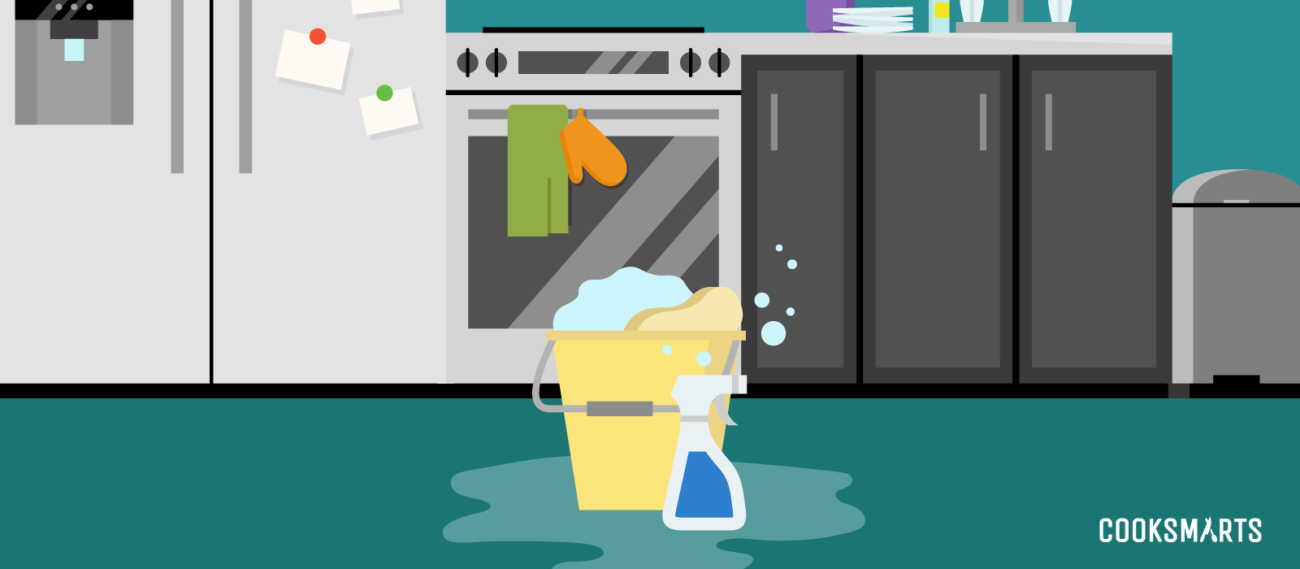
How to Keep Your Kitchen Clean
The Supplies You Need
Most of the cleaning supplies we recommend below are natural products and are so common you probably already have them in your home. Here’s what you need:
- Salt
- Lemons
- Baking soda
- Mild dish soap
- Distilled white vinegar
- Household disinfectant cleaner
- Ceramic glass cleaner (optional)
- Sponge
- Microfiber cloth
- Toothbrush or small brush
Kitchen Maintenance Guide
A handy infographic that tells you what kitchen appliances and areas to clean, how to do it and how often to repeat the process.
Kitchen Cleaning Schedule: What, How and When
The infographic above shows you the most common kitchen appliances and areas that need to be cleaned as well as how and when to do it — think of it as your little kitchen helper!
Now that you have the supplies you need, it’s time to dig into the kitchen cleaning tasks.
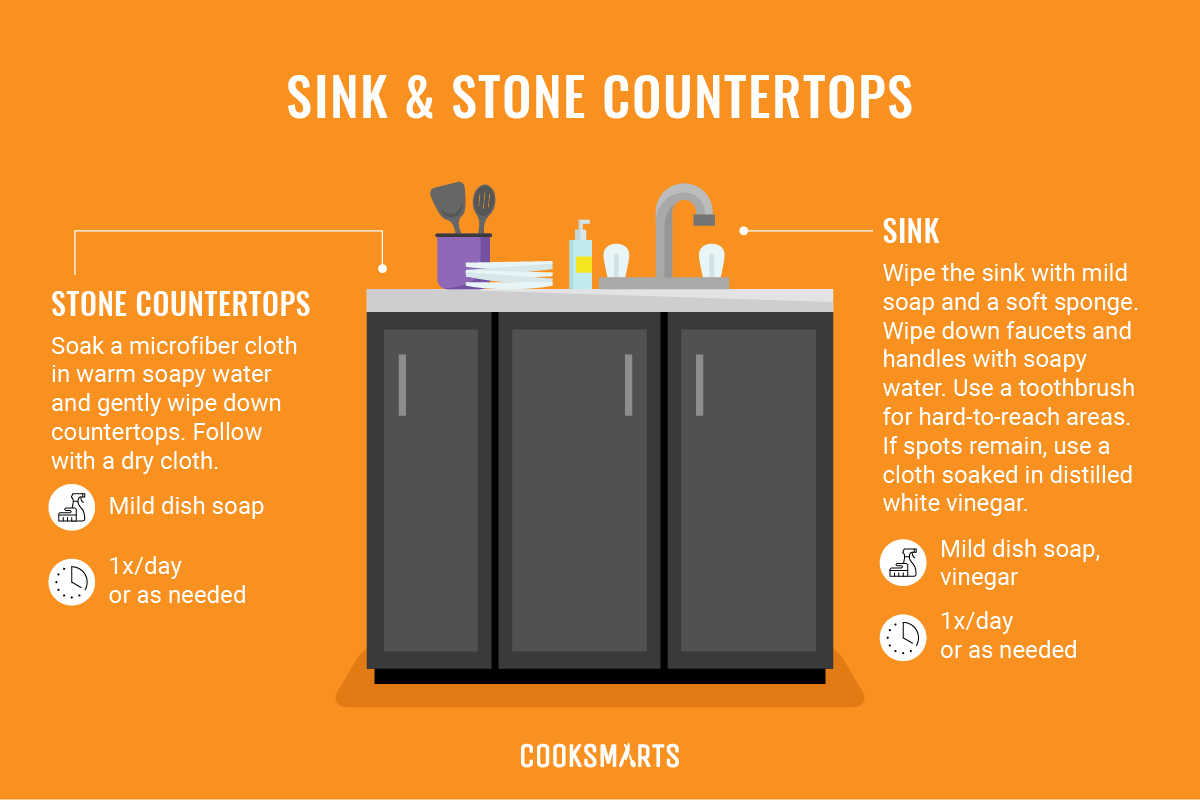
When and How to Clean a Sink
The sink is one of the most used parts of your kitchen. And since it’s where all of your dirty dishes go, keeping it nice and clean is a daily task. Here’s how to do it:
Maintenance Needed
After you wash your final dishes of the day, add a few drops of mild dish soap to a wet sponge and then wipe down the sink. For the faucets and handles, use soapy water and a sponge, and a toothbrush to clean hard-to-reach areas. If spots remain, soak a cloth in distilled white vinegar to remove them.
Cleaning Solution
- Mild dish soap
- And / or distilled white vinegar
Cleaning Frequency
- Once a day or as needed.
When and How to Clean Stone Countertops
Some stone countertops are naturally more porous and prone to scratches and stains than others. So paying attention to the type of cleaning solution you use on stone countertops is important. As a rule of thumb, avoid harsh chemicals and acidic solutions like vinegar or lemon juice that can etch the stone over time. Instead, use mild cleaning solutions and non-abrasive cloths. Here’s how to do it:
Maintenance Needed
Soak a microfiber cloth in warm soapy water and then gently wipe down the countertops. To remove any excess water on the counters, follow up with a dry cloth.
Cleaning Solution
- Mild dish soap
- Microfiber cloth
Cleaning Frequency
Once a day or as needed.
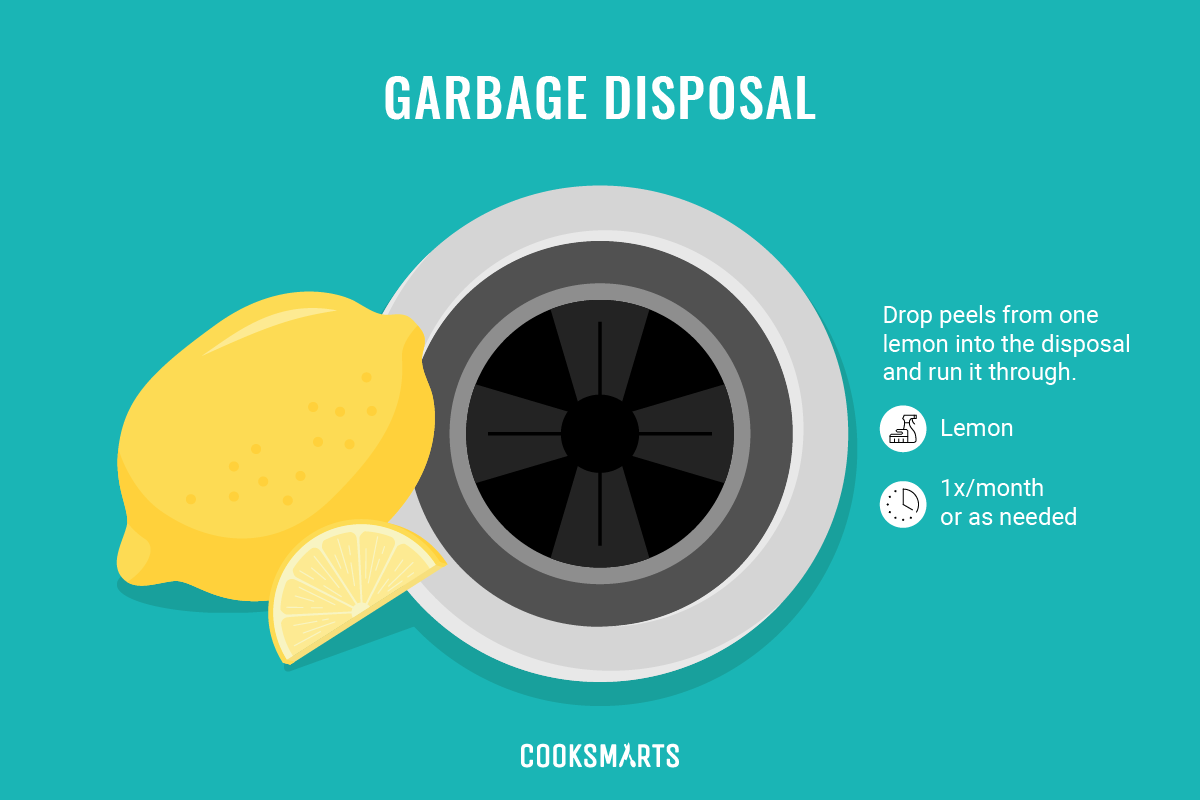
When and How to Clean a Garbage Disposal
When you have a phantom smell in your kitchen that you can’t trace it back to food or the garbage, it’s likely coming from the garbage disposal. Here’s how to freshen it up:
Maintenance Needed
Drop lemon peels into the garbage disposal and run them through.
Cleaning Solution
- Lemon
Cleaning Frequency
Once a month or as needed.
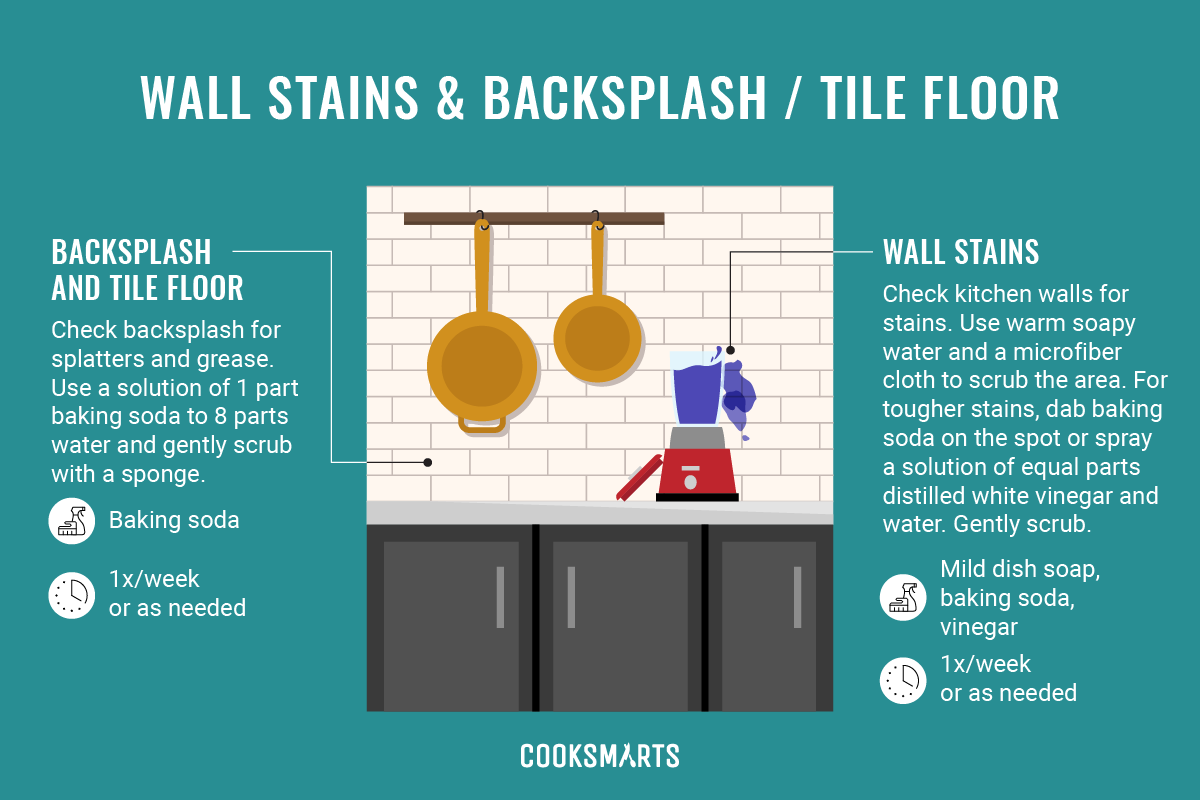
When and How to Clean Kitchen Wall Stains
Grease and spills can accumulate on your kitchen walls, especially around your stove. To keep your walls spot-free, check them for stains once a week. Here’s what to do if you find any:
Maintenance Needed
Dampen a microfiber cloth with warm soapy water and gently scrub the area. Scrubbing too hard can damage paint, so try to go lightly. If the stains are tougher to remove, dab baking soda on the spot or spray a solution of equal parts distilled white vinegar and water for more cleaning power.
Cleaning Solution
- Mild dish soap
- Baking soda
- Vinegar
Cleaning Frequency
Once a week or as needed.
When and How to Clean Kitchen Backsplash and Tile Floors
Like kitchen walls, tile backsplash and floors are prone to splashes and spills. Here’s what to do to keep them clean:
Maintenance Needed
Make a solution of 1 part baking soda to 8 parts water. Wet a sponge with the solution and gently scrub the tile.
Cleaning Solution
- Baking soda
Cleaning Frequency
Once a week or as needed.

When and How to Clean a Kitchen Trash Can
By default, trash cans are pretty dirty, but you can reduce the “yuck” factor by taking a proactive approach to cleaning. Here’s what to do:
Maintenance Needed
If your trash can is large or particularly dirty take it outside and hose it down. Or clean it in the bathtub. Use a disinfectant cleaner or a solution of equal parts vinegar and water to cut excess grease.
Cleaning Solution
- Disinfectant cleaner
- Vinegar
Cleaning Frequency
Two times a month or as needed.
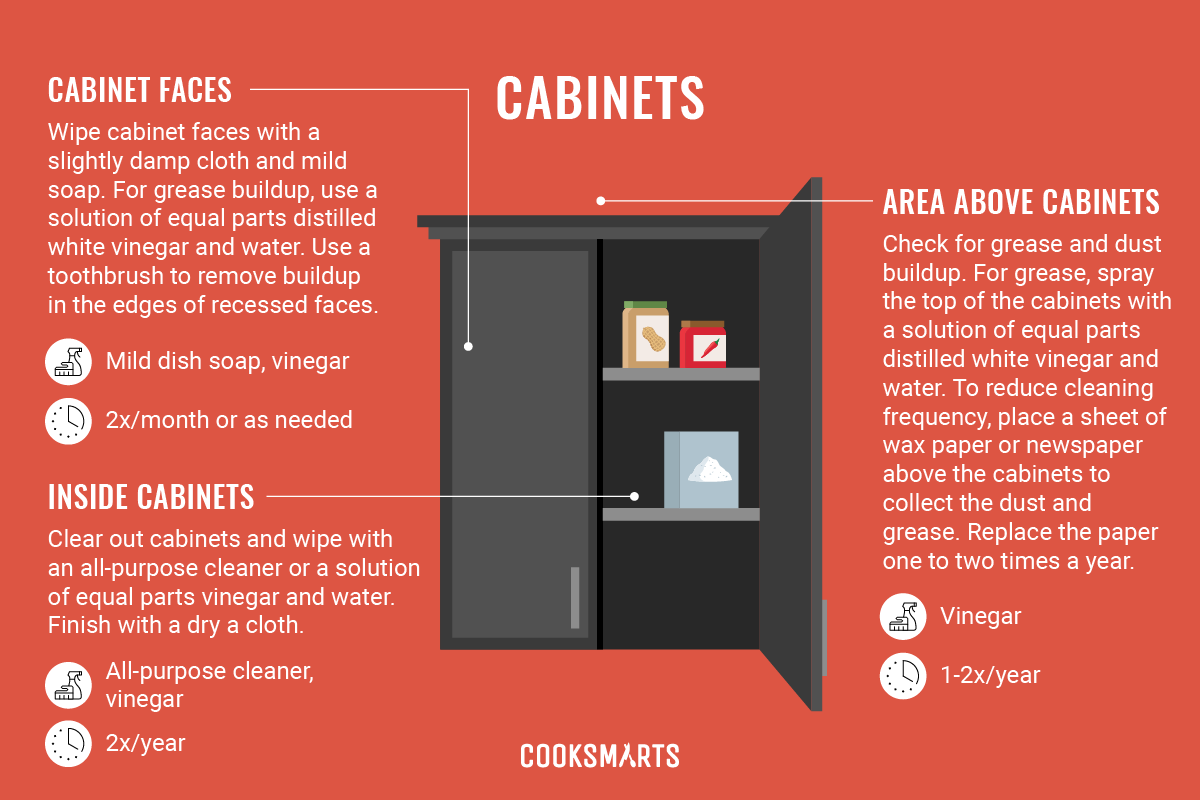
When and How to Clean Cabinet Faces
Cabinet faces can collect dust, oils from hands and splashes from food. To keep them clean, here’s what to do:
Maintenance Needed
Wipe down cabinet faces using a damp cloth with mild soap. If there’s grease buildup, make a solution of equal parts distilled white vinegar and water, and wipe. For recessed faces, use a toothbrush to get into hard-to-reach corners.
Cleaning Solution
- Mild dish soap
- Baking soda
- Vinegar
Cleaning Frequency
Twice a month or as needed.
When and How to Clean Inside Kitchen Cabinets
Every once in a while, it’s a good idea to clean out your kitchen cabinets to freshen up your space. Here’s how to do it:
Maintenance Needed
Remove all dishes and items from your cabinets. With an all-purpose cleaner or a solution of equal parts vinegar and water, wipe them down. Follow up with a dry cloth.
Cleaning Solution
- Vinegar
Cleaning Frequency
Two times a year.
When and How to Clean the Area Above Kitchen Cabinets
The area above your cabinets is prone to collecting dust and grease, and since it’s out of sight, planning a yearly cleaning check-up is a great way to keep the space tidy. Here’s what to do:
Maintenance Needed
If you find grease, spray the top of the cabinets with a solution of equal parts distilled white vinegar and water and wipe clean. To reduce the cleaning frequency, place a sheet of wax paper or newspaper above the cabinets to collect the dust and grease. Replace the paper one to two times a year.
Cleaning Solution
- Vinegar
Cleaning Frequency
One to two times a year.
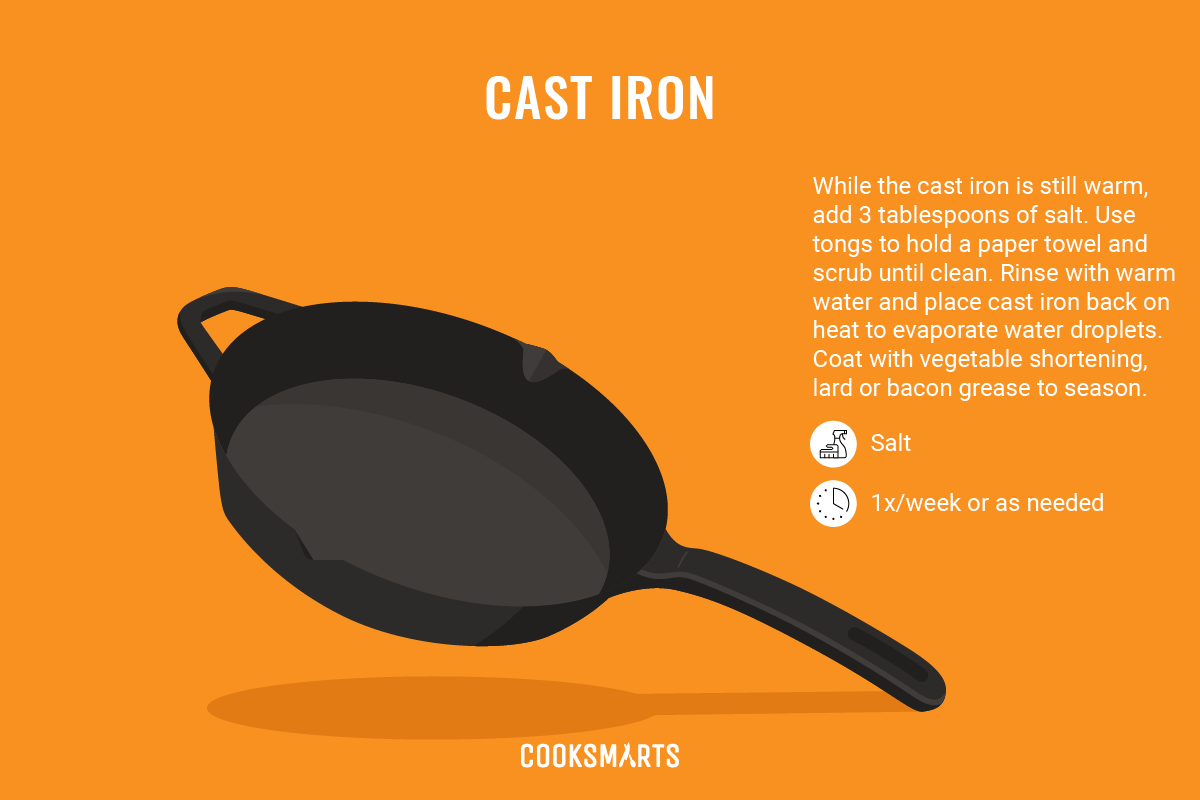
When and How to Clean a Cast Iron Skillet
If a cast iron skillet isn’t well-seasoned (coated in oil) or if it stays in water for too long, it can rust. So when you clean your cast iron it’s important to follow through with the entire maintenance process that includes re-seasoning to make sure it lasts for years to come. Here’s how to clean and season your cast iron:
Maintenance Needed
While your cast iron is still warm from the stove, add to it 3 tablespoons of salt. Use a pair of tongs to hold a paper towel and then scrub the cast iron. When it’s free of food debris, rinse the cast iron off in the sink and place it back on the heated stove to evaporate the remaining water droplets. To finish off the cleaning process, remove the cast iron from the stove and coat it with vegetable shortening, lard or bacon grease to season it.
Cleaning Solution
- Salt
Cleaning Frequency
Once a week or as needed.
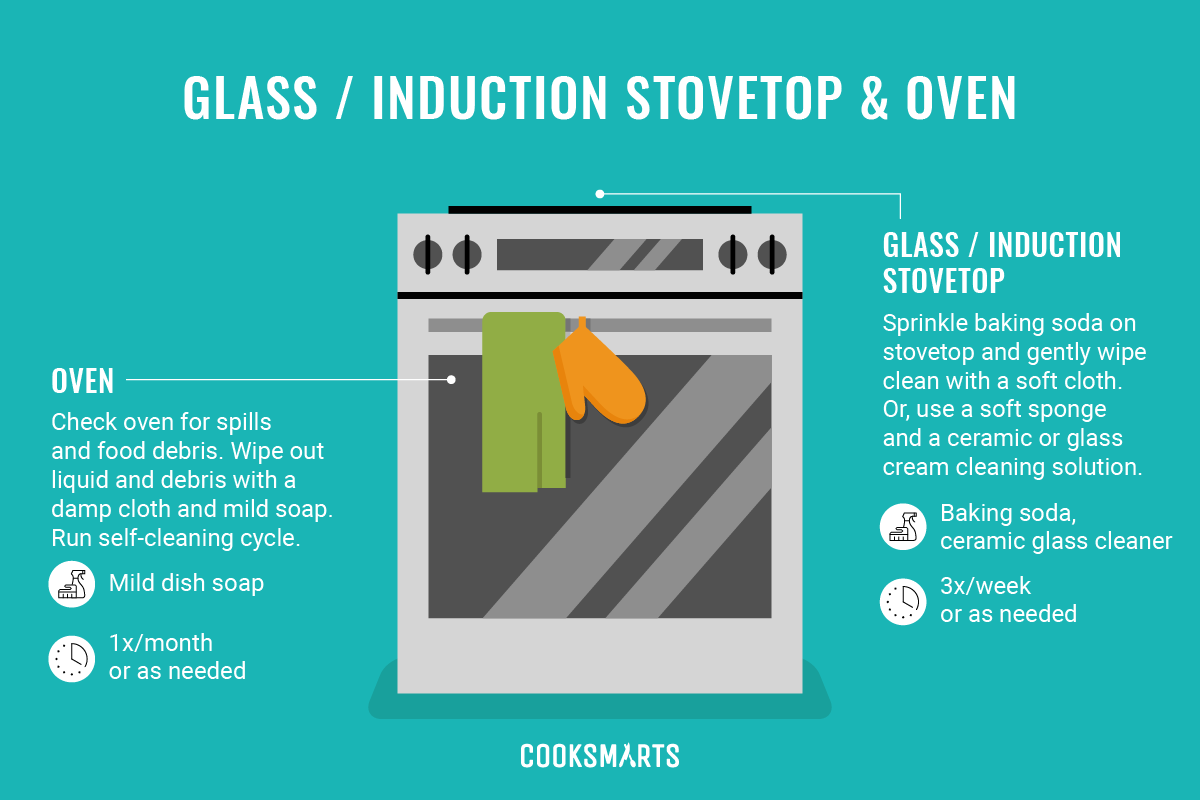
When and How to Clean a Glass or Induction Stovetop
Glass and induction stovetops are flat and easy surfaces to clean, however, they can scratch easily if you aren’t careful. So when you’re cleaning up spills and splashes on your glass stovetop, it’s good to use non-abrasive materials — only non-scratch scouring pads here! — and gentle solutions. If you want to be sure you’re using the right stuff, pick up a bottle of ceramic glass cleaner for your stovetop. Whether you buy a solution or make your own, here’s what to do:
Maintenance Needed
Sprinkle baking soda on your stovetop and gently wipe with damp cloth. For ceramic glass cleaner, squeeze some of the cream onto the stovetop and gently rub in with a soft sponge and then follow with a dry cloth.
Cleaning Solution
- Baking soda
- And/or ceramic glass cleaner
Cleaning Frequency
3 times a week or as needed.
When and How to Clean an Oven
Most ovens have a self-cleaning cycle, but before you use it, it’s important to remove all food debris and liquid spills that have collected on the bottom to avoid starting a fire in the oven. Here’s what to do:
Maintenance Needed
If you spot liquid and food debris, use a damp cloth with mild soap to wipe it out. Then run the self-cleaning cycle to get the interior sparking.
Cleaning Solution
- Mild dish soap
Cleaning Frequency
Once a month or as needed.
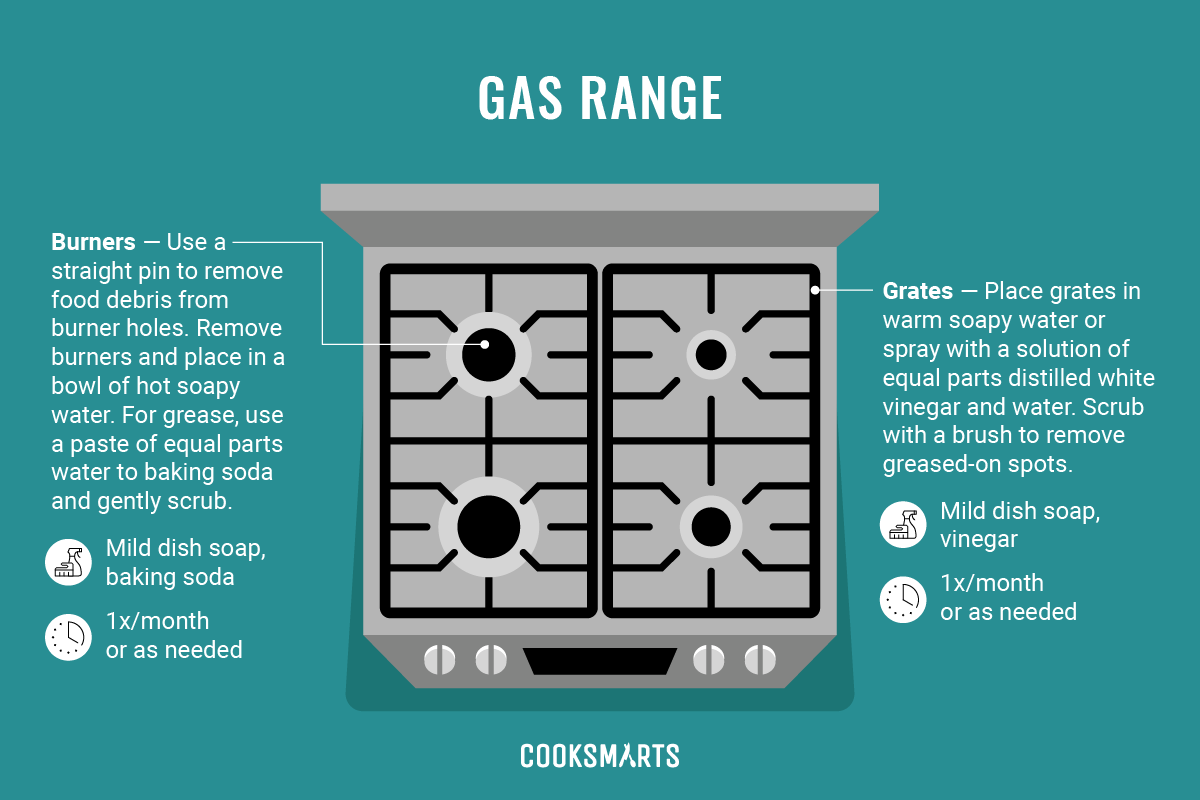
When and How to Clean a Gas Range
Your gas range has two components that need to be cleaned regularly: the grates and the burners. To cut through caked-on grease, we recommend an acidic solution like vinegar and water, or a slightly abrasive paste made with baking soda. Here’s how to do it:
Maintenance Needed
- Grates. If your grates are relatively clean, soak them in warm soapy water and then scrub them. For tougher grease, spray them with a solution of equal parts distilled white vinegar and water before scrubbing.
- Burners. Remove food debris from the burner holes with a straight pin. If there’s minimal grease, place the burners in warm soapy water and then scrub them. For stuck-on grease, make a paste of equal parts baking soda and water and gently scrub them.
Cleaning Solution
- Vinegar
- Mild dish soap
- Baking soda
Cleaning Frequency
Once a month or as needed.
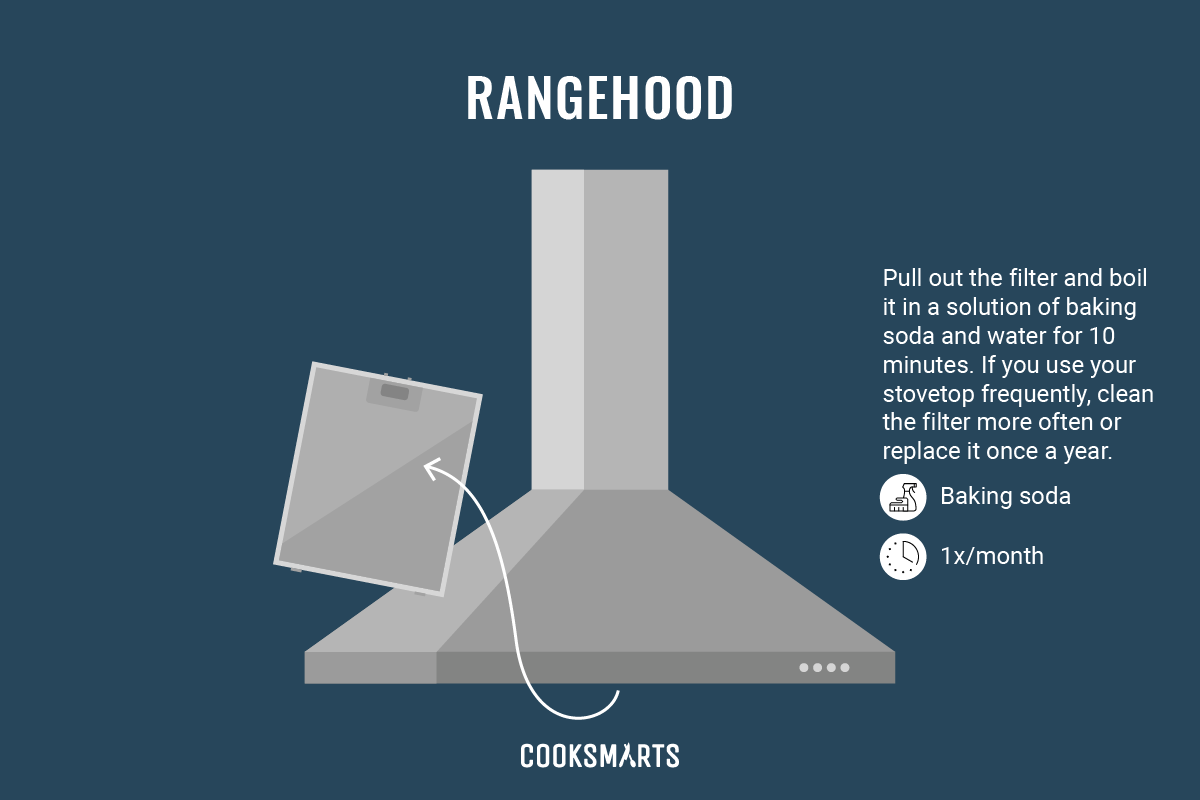
When and How to Clean a Range Hood
The filter in your range hood can collect grease, so it’s important to clean it once a month to keep it filtering smoothly. Here’s how to do it:
Maintenance Needed
Boil the filter in a solution of baking soda and water for 10 minutes. Clean the filter more often if you use your stovetop frequently or replace it once a year.
Cleaning Solution
- Baking soda
Cleaning Frequency
Once a month or as needed.
When and How to Clean Electric Stove Coils
Over time, the coils on your electric stove can get coated in grease and food debris. To keep them working at their best and to avoid accidental burning of debris, here’s what to do:
Maintenance Needed
Pull out coils and wipe them down with mild dish soap and a damp cloth. For stuck-on grease, make a paste of baking soda and water and, using a cloth, gently scrub it on the coils. Carefully rinse off the remaining baking soda paste, making sure not to submerge them in water or wet the electrical connections.
Cleaning Solution
- Mild dish soap
- Baking soda
Cleaning Frequency
Once a month or as needed.
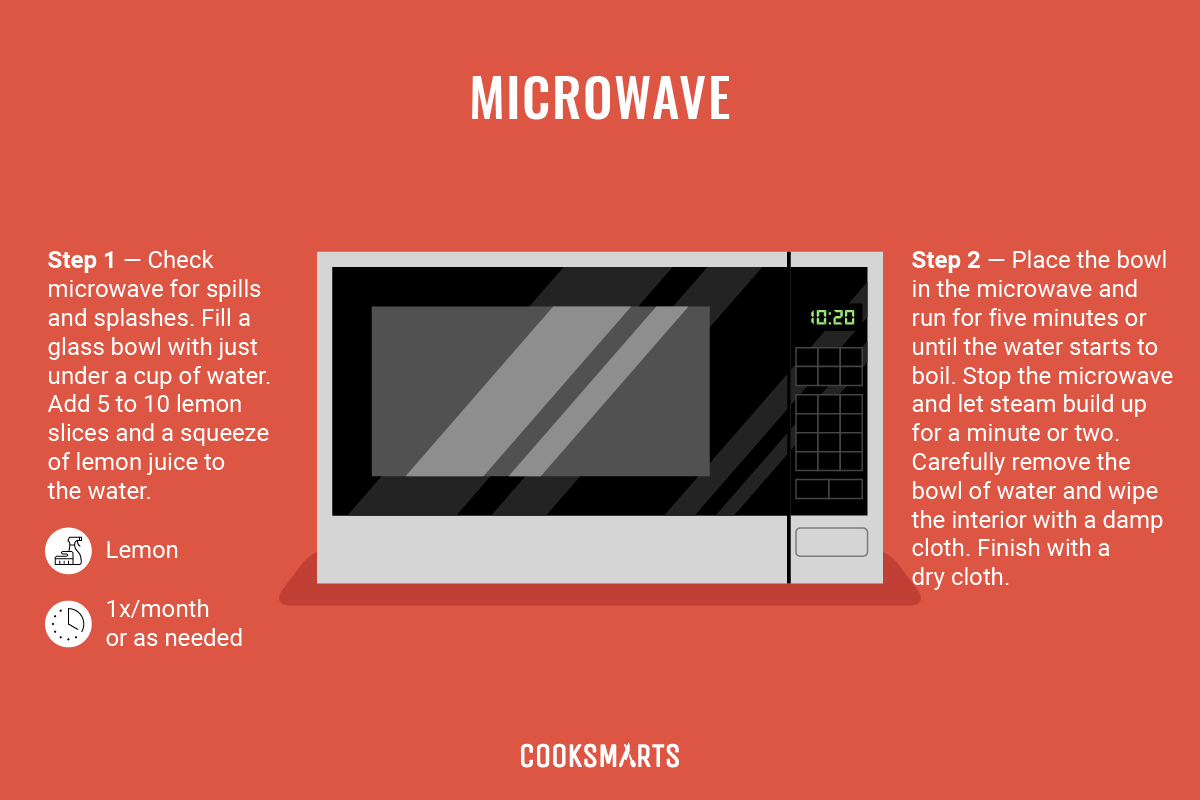
When and How to Clean a Microwave
When you find spills and splashes in your microwave, steam clean them with a combination of hot water and lemons. Here’s how to do it:
Maintenance Needed
Cut 5 to 10 slices of lemon. Squeeze some of the lemon juice into a glass bowl that’s filled with just under a cup of water and then add in the slices. Place the bowl in the microwave and run it for five minutes or until the water begins to boil. Then stop the microwave to let steam build up for a minute or two. Then carefully remove the bowl of water and wipe out the microwave with a damp cloth. To remove any excess moisture, follow with a dry cloth.
Cleaning Solution
- Lemon
Cleaning Frequency
Once a month or as needed.
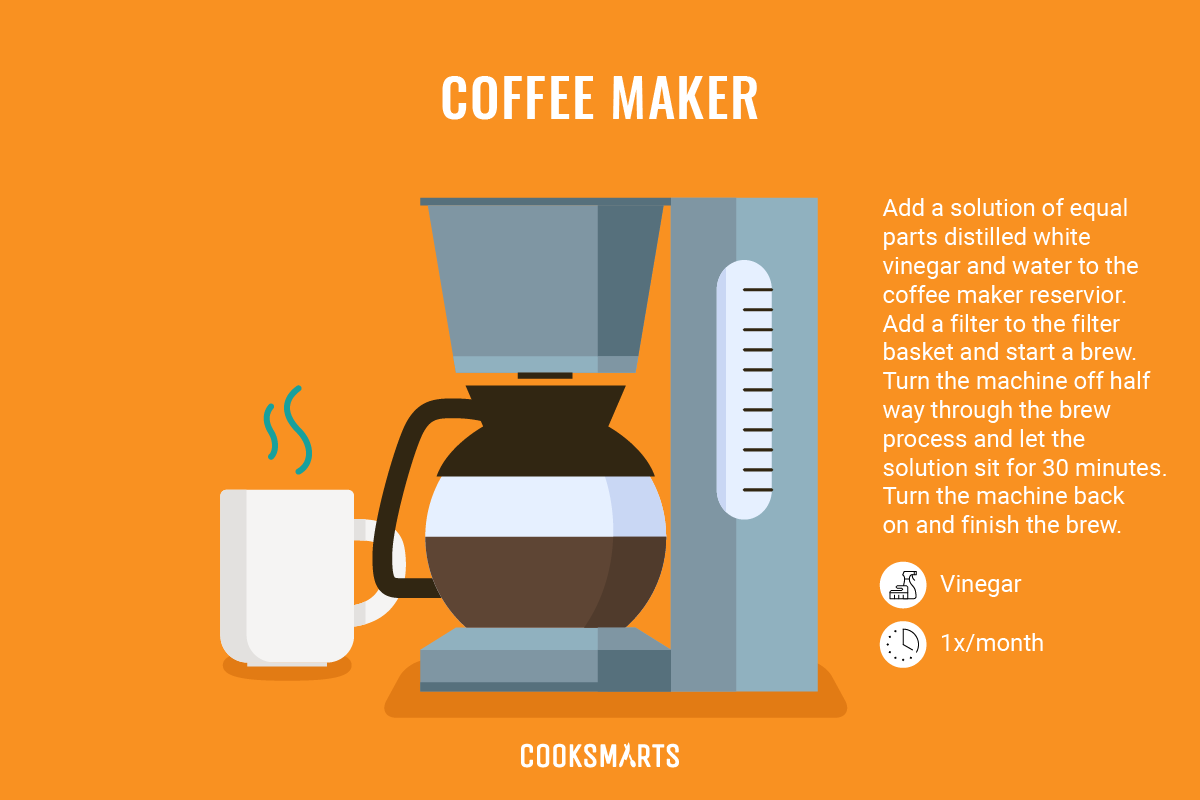
When and How to Clean a Coffee Maker
Mineral deposits can build up inside your coffee maker, hampering its performance and creating off-tastes in your brew. Here’s how to clean it:
Maintenance Needed
Make sure the reservoir on your coffee maker is empty. Make a solution of equal parts distilled white vinegar and water and add to the reservoir. Place a filter in the coffee maker and start a brew cycle. Halfway through the brew, turn off the machine and let it sit for 30 minutes. When the time is up, turn the machine back on and finish the brew.
Cleaning Solution
- Vinegar
Cleaning Frequency
Once a month.
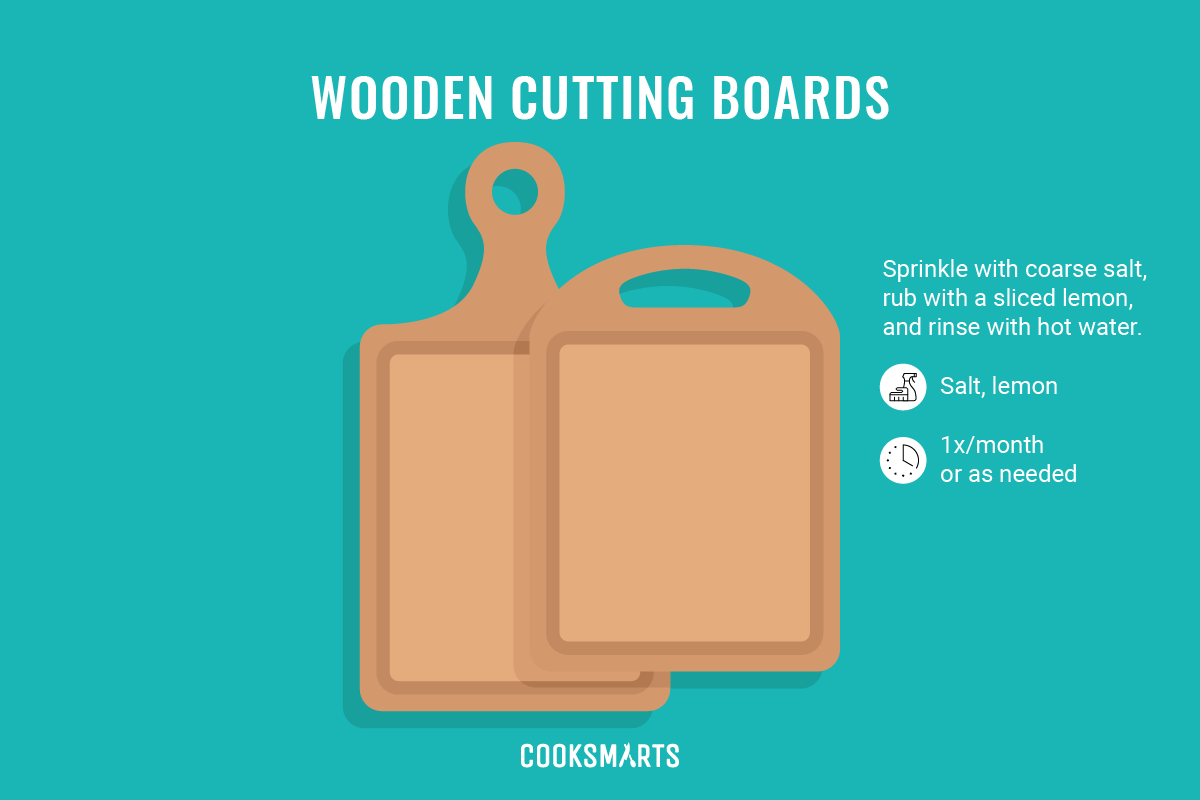
When and How to Clean a Wooden Cutting Board
A wooden cutting board needs a bit more specialty care to ensure the wood stays healthy and holds up for the long run. Here’s how to clean your wooden cutting board:
Maintenance Needed
Sprinkle coarse salt on the cutting board. Use a sliced lemon to rub the salt across the surface of the board. Then rinse with hot water and dry standing up.
Cleaning Solution
- Salt
- Lemon
Cleaning Frequency
Once a month or as needed.
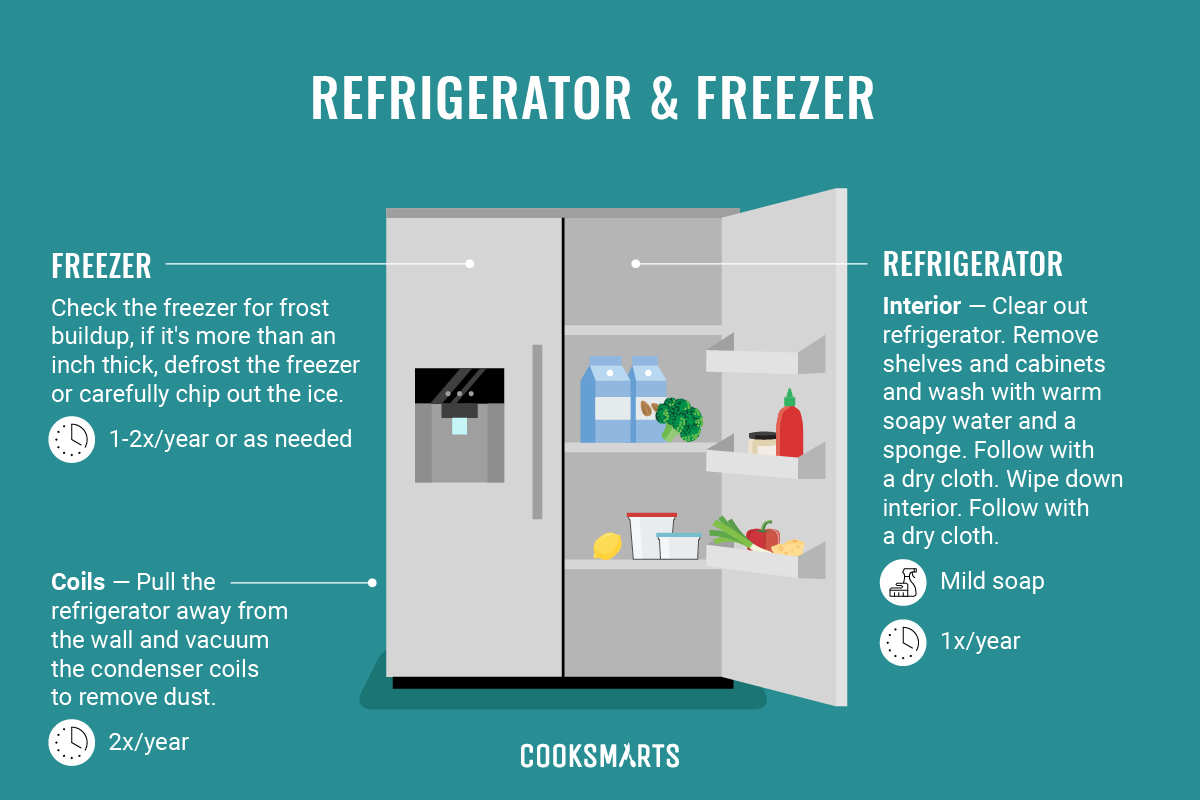
When and How to Clean a Refrigerator
To keep your refrigerator running and looking its best, there are two areas you need to keep tidy: the interior and the condenser coils. Here’s how to clean them:
Maintenance Needed
- Interior. Remove all food from the refrigerator and take out shelves and cabinets. Wash shelves and cabinets with warm soapy water and a sponge. Then dry with a cloth. Use the soapy sponge to wipe out the interior and remove any food debris. Then dry with a cloth.
- Coils. Pull the refrigerator away from the wall and vacuum the condenser coils on the back to remove dust. If you’d like a video, we recommend this or this.
Cleaning Solution
- Mild soap
Cleaning Frequency
- Interior. Once a month or as needed.
- Coils. Two times a year.
When and How to Clean a Freezer
When frost builds up it can take up space in your freezer or cause blockages. A small amount of frost is normal, especially if you frequently open and close your freezer; however, large amounts of frost are not. So if you notice lots of frost that keeps coming back, it’s a good idea to check your freezer manual for potential issues like door gasket malfunction. Here’s what to do to remove normal frost:
Maintenance Needed
If frost is more than an inch thick, defrost the freezer or carefully chip out the ice.
Cleaning Frequency
One to two times a year or as needed.
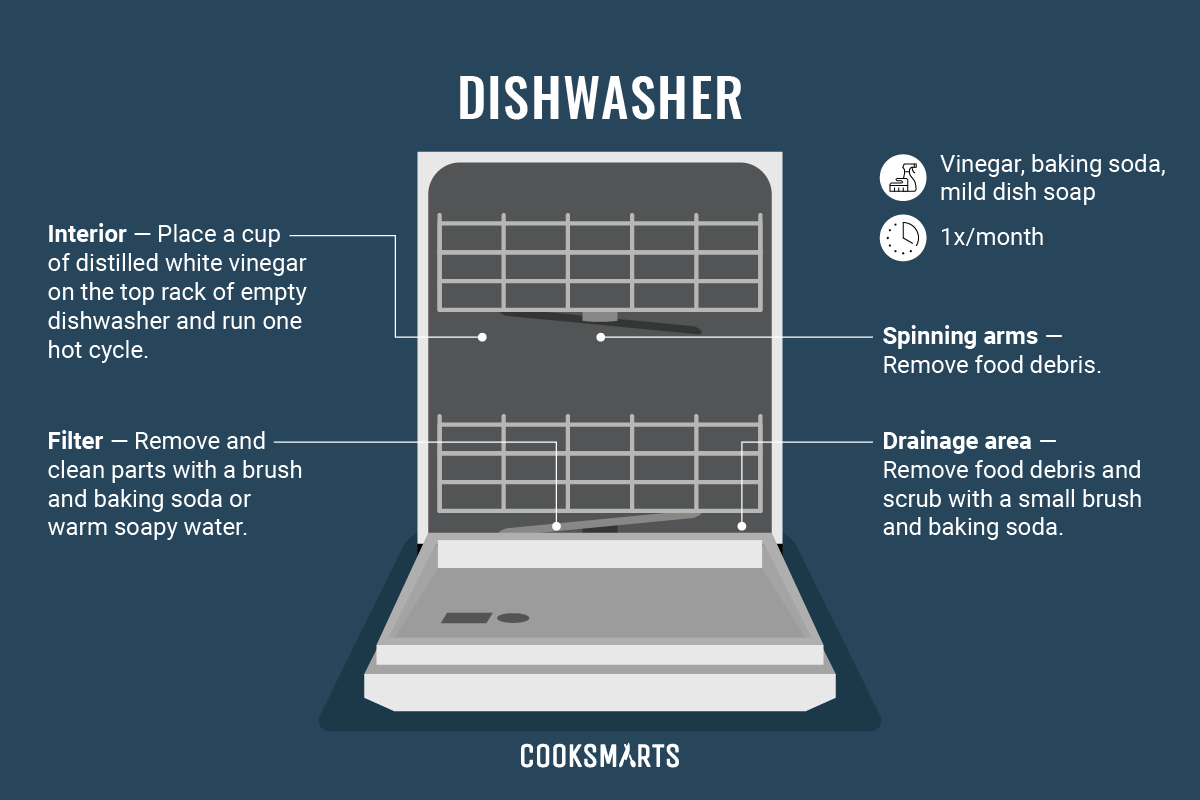
When and How to Clean a Dishwasher
Food debris and hard water stains can build up in your dishwasher causing it to lose performance and sparkle. Here’s how to keep your dishwasher looking and performing at its best:
Maintenance Needed
- Spinning arms. Remove food debris from water holes in the spinning arms.
- Drainage area. Remove any food debris from the floor of the dishwater, especially around the drainage area. Then sprinkle a small amount of baking soda around the drain and scrub with a small brush.
- Filter. Remove the filter and clean all parts with a brush and baking soda or warm soapy water.
- Interior. To steam clean the interior and keep hard water stains at bay, place a cup of distilled white vinegar on the top rack of empty dishwasher and run one hot cycle.
Cleaning Solution
- Vinegar
- Baking Soda
Cleaning Frequency
Once a month.
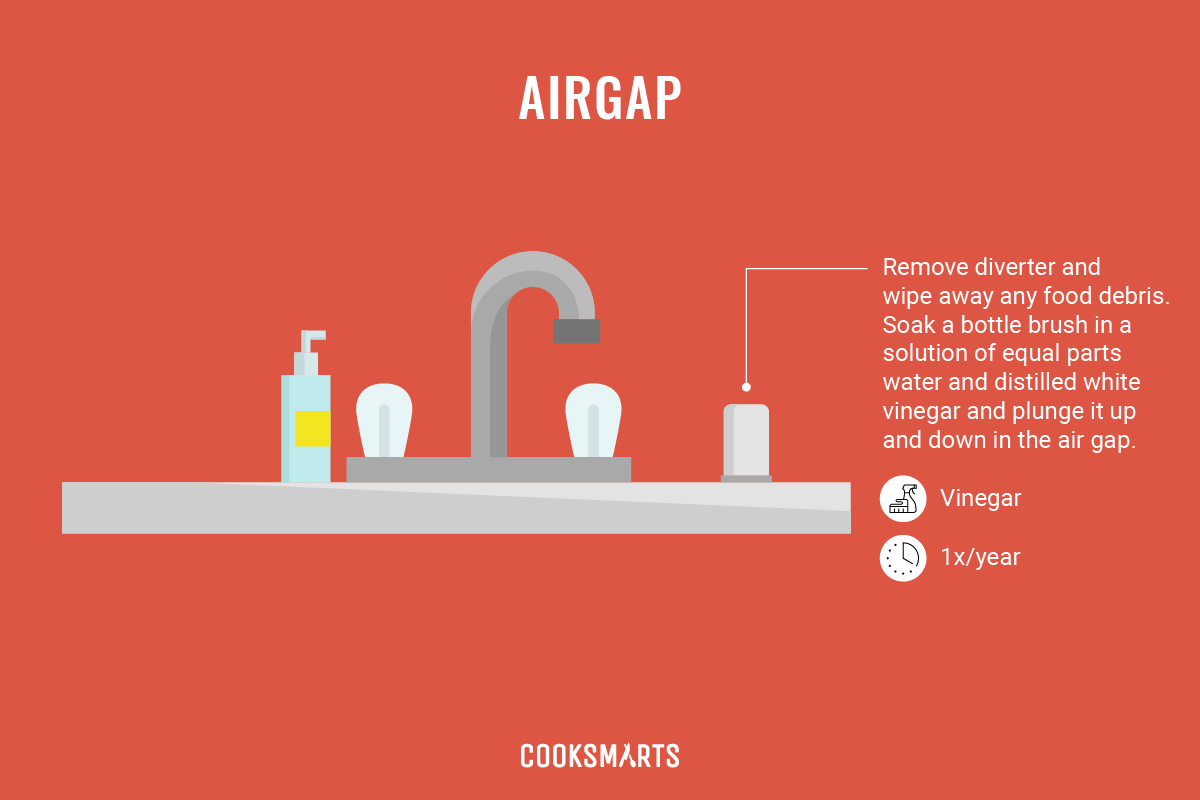
When and How to Clean an Air Gap
The air gap acts as a form of backflow prevention that keeps contaminants from the sink from entering water from your tap. To keep it functioning at its best, here’s what to do:
Maintenance Needed
Remove diverter and wipe away any food debris. Soak a bottle brush in a solution of equal parts water and distilled white vinegar and plunge it up and down in the air gap. Here’s a short video from LG showing you how to do it.
Cleaning Solution
- Vinegar
Cleaning Frequency
Once a year.
Kitchen Maintenance Tips
You’re almost ready to tackle your cleaning like a pro, but first, there are a few more kitchen maintenance tips we want to share.
- Use a Digital Calendar. To keep track of your kitchen tasks as easy as possible, schedule them into Google calendar or use a reminder app.
- Call in a Real Pro (or Another Family Member). If you don’t love cleaning, delegate it to another family member or divide up the tasks between the family. Or, if you can afford it, hire someone to do it!
- Keep Yourself Entertained. To make cleaning feel less like a burden, pop in some headphones and fire up your favorite album or podcast to pass the time.
- Pre-Mix Cleaning Solutions. Keep a solution of distilled white vinegar and water in a spray bottle so it’s ready to go when you are.
- Streamline Your Processes for Faster Kitchen Cleanup. Make it easier to keep your kitchen clean daily by optimizing your workflow with these 12 tips.
How do you keep your kitchen neat and tidy? Any kitchen maintenance tips you want to share? Let us know in the comments!
As always, we’re here to help you live your best life in the kitchen and provide delicious memories for you and your family. For more cooking tips and resources sent straight to your inbox, sign up for our newsletter below, and we’ll help you raise your kitchen IQ and cook with confidence!

